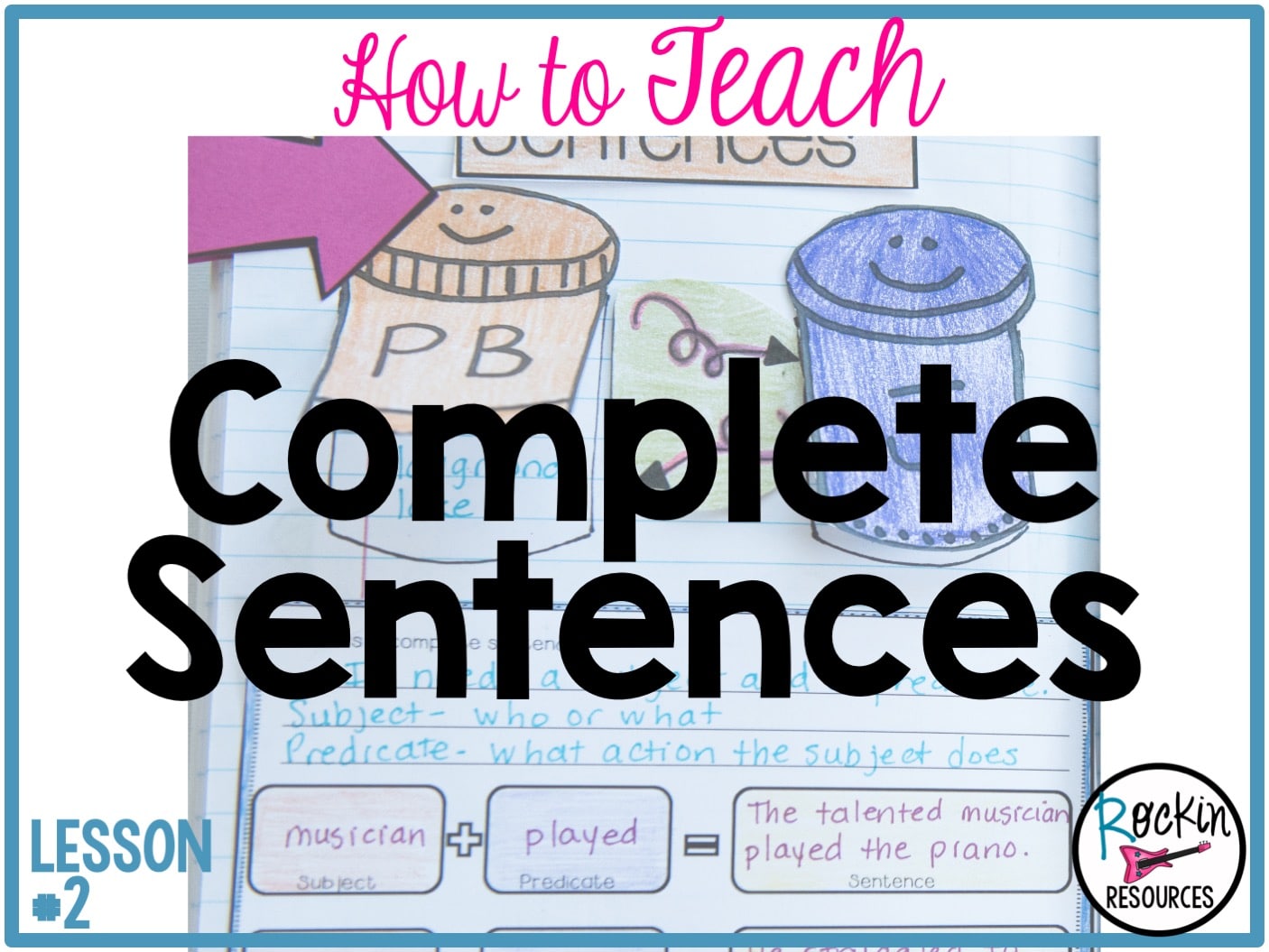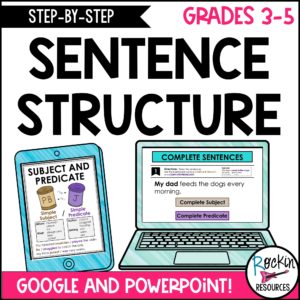This lesson will focus on writing COMPLETE SENTENCES using subjects and predicates. Writing in complete sentences is the first basic writing lesson every student should learn. Sentence structure is important to help students write in journals, responses to reading, paragraphs, essays, book reports and so much more. It will lay the foundation for good writing practices throughout the year! These ideas are ideal for any writing curriculum and are a part of a series of mini-lessons for writer’s workshop designed to scaffold through sentence structure, paragraph writing, and essay writing. Read on to learn how to teach complete sentences using subjects and predicates.
1. Teach
Teacher-made anchor charts or enlarging a digital poster on a smart board is idea for teaching your visual learners. I try to provide some sort of visual with each skill to help the students remember the meaning of the lesson. For a perfectly delicious Peanut Butter and Jelly sandwich, you can’t leave out the peanut butter or the jelly! It is the same with sentences. A sentence is only complete with a subject AND a predicate! A subject is a noun (person, place, or thing) and a predicate is a verb (action or linking).
SUBJECT- who or what the sentence is about.
Ex. musician, player, he, playground, lake, jacket
PREDICATE- what action the subject does or links the subject by telling what the subject is.
Ex. played, struggled, flapping, is, were, am
Examples:
The talented musician played the violin.
He struggled to catch the ball.
My thick jacket was very warm.
You can also teach complete sentences and complete predicates. Everything that belongs with the subject is the complete subject and everything that belongs with the predicate is the complete predicate.
Examples:
The talented musician played the violin.
He struggled to catch the ball.
My thick jacket was very warm.
2. Take Notes
I like to have students take notes using Interactive Notes. Research supports the use of interactive notes through studies on multiple intelligence, note-taking, and the brain! This can be done through INTERACTIVE WRITING NOTEBOOKS or DIGITAL NOTES.
Here are videos about SETTING UP INTERACTIVE WRITING NOTEBOOKS.
3. Group or Partner PRACTICE
Have students practice by writing a paragraph or 5 sentences in a group or with a partner. This is helpful because they can share their knowledge with each other. I know they haven’t learned paragraph writing yet (it is later in this series of writing lessons) but sometimes its easier for them to write about a particular topic as opposed to coming up with 5 different sentences. You know your students so choose what is best for them! Practice is what is important. Have other students underline the subject and circle the predicate in each sentence. Motivate them by providing two different colors of pens, pencils, or crayons for this activity! If they have brown for peanut butter and purple for grape jelly, that would be fun!
4. Independent Practice
Provide independent practice for your students. Have students identify the subjects and predicates in sentences. TASK CARDS OR DIGITAL INTERACTIVE SELF-CHECKS are a great way to give students practice at home or in centers.
5. Apply
Students should now apply their knowledge by writing in complete sentences. Give them a topic or prompt to write about in their writing notebooks. (A cute idea is to ask them to explain how to write in complete sentences using complete sentences!) Tell them to underline the subject and circle the predicate in each sentence.
6. Share
Share some of the student-made sentences with the class and point out the subjects and predicates.
7. Independent Assessment
Once you think your students had enough practice, give them an independent assessment and track their progress. This useful information can be used with forming small instructional groups or end of year review.
USEFUL TIP: When writing responses to questions, have students write in COMPLETE SENTENCES by repeating part of the question in their answer.
For example: Why did Mary show Dickon the garden? Mary showed Dickon the garden because………. This will give them practice writing complete sentences throughout the year!
I hope these ideas will help you and your students! ROCK ‘N’ WRITE!!!!!
Check out my FREE writing masterclass! CLICK HERE
LAST LESSON: MINI LESSON #1- BRAINSTORMING IDEAS
NEXT LESSON: MINI LESSON #3- FRAGMENTS
CLICK HERE FOR THE FULL LIST OF WRITING MINI LESSONS
Do you need a complete NO PREP Sentence Structure ? There are anchor charts, interactive notes, and practice for each of the following: Complete Sentences, Fragments, Run-On Sentences along with an assessment. (There is a primary version too!)
This lesson is also included in the STEP-BY-STEP WRITING® Program with mini-lessons designed to scaffold through the writing process. Writing units included are sentence structure, paragraph writing, narrative writing, opinion writing, and informative writing. See what is included in the image below and click on it to learn more about them! You will turn your reluctant writers into ROCKSTAR WRITERS™!
“Teaching writing is my weakness. I knew that, so spent my summer reading about it, exploring different resources, following blogs, etc. I purchased this one and I’m so pleased that I did. Not only is it teaching my students to be better writers, it’s helping me learn to be better at teaching writing. Thank you.” -Rachel T.










